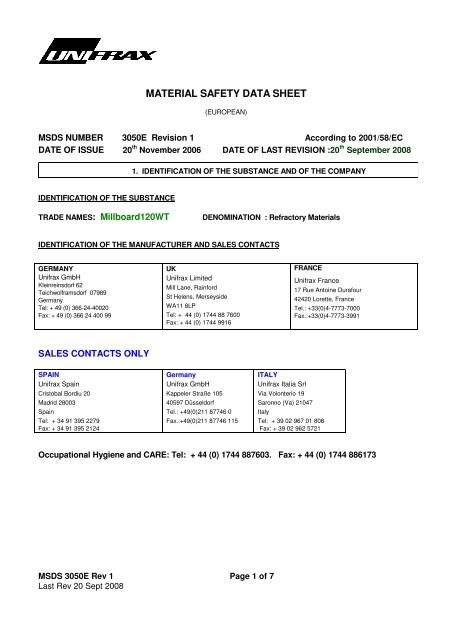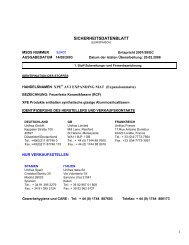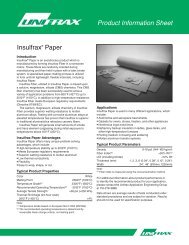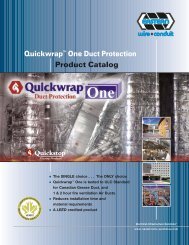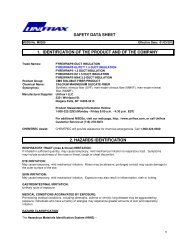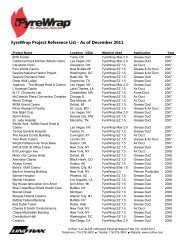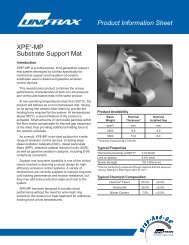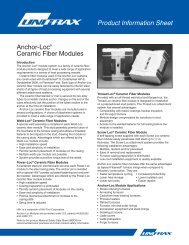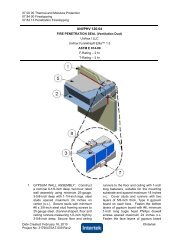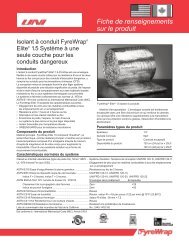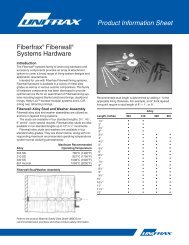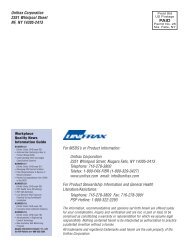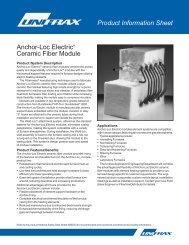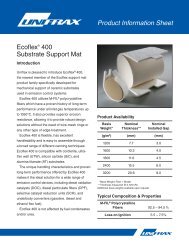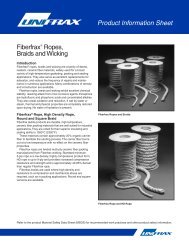Millboard 120WT MSDS - Unifrax
Millboard 120WT MSDS - Unifrax
Millboard 120WT MSDS - Unifrax
You also want an ePaper? Increase the reach of your titles
YUMPU automatically turns print PDFs into web optimized ePapers that Google loves.
MATERIAL SAFETY DATA SHEET<br />
(EUROPEAN)<br />
<strong>MSDS</strong> NUMBER 3050E Revision 1 According to 2001/58/EC<br />
DATE OF ISSUE 20 th November 2006 DATE OF LAST REVISION :20 th September 2008<br />
IDENTIFICATION OF THE SUBSTANCE<br />
1. IDENTIFICATION OF THE SUBSTANCE AND OF THE COMPANY<br />
TRADE NAMES: <strong>Millboard</strong><strong>120WT</strong> DENOMINATION : Refractory Materials<br />
IDENTIFICATION OF THE MANUFACTURER AND SALES CONTACTS<br />
GERMANY<br />
<strong>Unifrax</strong> GmbH<br />
Kleinreinsdorf 62<br />
Teichwolframsdorf 07989<br />
Germany<br />
Tel: + 49 (0) 366-24-40020<br />
Fax: + 49 (0) 366 24 400 99<br />
SALES CONTACTS ONLY<br />
SPAIN<br />
<strong>Unifrax</strong> Spain<br />
Cristobal Bordiu 20<br />
Madrid 28003<br />
Spain<br />
Tel: + 34 91 395 2279<br />
Fax: + 34 91 395 2124<br />
UK<br />
<strong>Unifrax</strong> Limited<br />
Mill Lane, Rainford<br />
St Helens, Merseyside<br />
WA11 8LP<br />
Tel: + 44 (0) 1744 88 7600<br />
Fax: + 44 (0) 1744 9916<br />
Germany<br />
<strong>Unifrax</strong> GmbH<br />
Kappeler Straße 105<br />
40597 Düsseldorf<br />
Tel.: +49(0)211 87746 0<br />
Fax.:+49(0)211 87746 115<br />
<strong>MSDS</strong> 3050E Rev 1 Page 1 of 7<br />
Last Rev 20 Sept 2008<br />
ITALY<br />
<strong>Unifrax</strong> Italia Srl<br />
Via Volonterio 19<br />
FRANCE<br />
Saronno (Va) 21047<br />
Italy<br />
<strong>Unifrax</strong> France<br />
17 Rue Antoine Durafour<br />
42420 Lorette, France<br />
Tel: + 39 02 967 01 808<br />
Fax: + 39 02 962 5721<br />
Tel.: +33(0)4-7773-7000<br />
Fax.:+33(0)4-7773-3991<br />
Occupational Hygiene and CARE: Tel: + 44 (0) 1744 887603. Fax: + 44 (0) 1744 886173
2. COMPOSITION / INFORMATION OF INGREDIENTS<br />
COMPONENT CAS NUMBER SYMBOL R PHRASES<br />
Aluminium silicate 1318-74-7 None None<br />
Calcium silicate 13983-17-0 None None<br />
COMPOSITION<br />
Cellulose 9004-34-6 None None<br />
<strong>Millboard</strong>s <strong>120WT</strong>: 43-46% Calcium silicate, 40-45% Aluminium silicate,
METHODS FOR CLEANING UP<br />
Pick up large pieces and use a vacuum cleaner fitted with high efficiency filter (HEPA)<br />
If brushing is used, ensure that the area is wetted down first.<br />
Do not use compressed air for clean-up.<br />
Do not allow to be wind blown.<br />
Do not flush spillage to drain and prevent from entering natural watercourses.<br />
Check for local regulations, which may apply.<br />
For wastes disposal refer to section 13<br />
7. HANDLING AND STORAGE<br />
HANDLING / TECHNIQUES TO REDUCE DUST EMISSIONS DURING HANDLING<br />
HANDLING<br />
Handling can be a source of dust emission.<br />
The Process or processes should be designed to limit the amount of handling. Whenever possible, handling<br />
should be carried out under controlled conditions (i.e., use dust exhaust system).<br />
Regular good housekeeping will minimise secondary dust dispersal.<br />
STORAGE<br />
Store in original packaging in dry area whilst awaiting use<br />
Always use sealed and visibly labelled containers.<br />
Avoid damaging containers.<br />
Reduce dust emission during unpacking.<br />
Emptied containers, which may contain debris, should be cleaned before disposal or recycling.<br />
HYGIENE STANDARDS AND CONTROL MEASURES<br />
8. EXPOSURE CONTROL / PERSONAL PROTECTION<br />
Hygiene standards and occupational exposure limits may vary between countries and local jurisdictions. Check<br />
which exposures apply to your facility. If no regulatory dust or other standards apply, a qualified industrial<br />
hygienist can assist with a specific workplace evaluation including recommendations for respiratory protection.<br />
Examples of exposure limits are given below:<br />
Exposure limit in January 2008 as given below:<br />
United Kingdom – Workplace Exposure Limits – HSE EH 40<br />
Total inhalable dust mg/m 3 Respirable dust mg/m 3<br />
Calcium Silicate 10 4<br />
Aluminium Silicate 10 4<br />
ENGINEERING CONTROLS<br />
Review your application(s) in order to identify potential sources of dust exposure.<br />
<strong>MSDS</strong> 3050E Rev 1 Page 3 of 7<br />
Last Rev 20 Sept 2008
Local exhaust ventilation, which collects dust at source, can be used. For example down draft tables, emission<br />
controlling tools and material handling equipment.<br />
Keep the workplace clean. Use a vacuum cleaner fitted with an HEPA filter; avoid brushing and using<br />
compressed air.<br />
PERSONAL PROTECTIVE EQUIPMENTS<br />
SKIN PROTECTION<br />
Wear gloves and suitable work wear or overalls, Contaminated clothes should be cleaned<br />
to remove excess dust before being taken off (e.g. use vacuum cleaner, not compressed air)..<br />
EYE PROTECTION<br />
As necessary wear goggles or safety glass with side shields<br />
RESPIRATORY PROTECTION<br />
For dust concentrations below the exposure limit value, RPE is not required but FFP2 respirators may be used<br />
on a voluntary basis.<br />
For short term operations where excursions are less than ten times the limit value use FFP2 respirators.<br />
In case of higher concentrations or where the concentration is not known, please seek advice from your<br />
company and/or your supplier.<br />
INFORMATION AND TRAINING OF WORKERS<br />
Workers should be trained on good working practices and informed on applicable local regulations.<br />
ENVIRONMENTAL EXPOSURE CONTROLS<br />
Refer to local, national or European applicable environmental permitted standards for release to air, water and<br />
soil.<br />
For waste, refer to section13<br />
9. PHYSICAL AND CHEMICAL PROPERTIES<br />
Physical State Solid Melting point >1300°C<br />
Flammability None<br />
Appearance Beige-brown Explosive properties None<br />
Oxidising properties None Odour None<br />
pH 8-10<br />
10. STABILITY AND REACTIVITY<br />
CONDITIONS TO AVOID N.A. MATERIALS TO AVOID N.A.<br />
DECOMPOSITION PRODUCTS<br />
Thermal decomposition of the organic binder above 150°C.<br />
<strong>MSDS</strong> 3050E Rev 1 Page 4 of 7<br />
Last Rev 20 Sept 2008
RESPIRATORY EFFECTS<br />
None expected in the normal use of the product.<br />
11. TOXICOLOGICAL INFORMATION<br />
During activities where there is the potential for dust generation, it may contain respirable crystalline silica, which<br />
has been classified by IARC (International Association for Research on Carcinogens) as a Category 1 carcinogen.<br />
The clay used to produce this product is of low acute toxicity, it is not classed as carcinogenic or genotoxic.<br />
Wollastonite is classed under IARC as group 3- there is inadequate evidence for carcinogenicity in humans.<br />
12. ECOLOGICAL INFORMATION<br />
These products are inert materials, which remain stable overtime.<br />
No adverse effects of this material on the environment are anticipated.<br />
13. DISPOSAL CONSIDERATIONS<br />
Waste from these products are classed as non hazardous and may generally be disposed of at landfill, which<br />
has been licensed for this purpose. Please refer to the European list (Decision no 2000/532/CE as modified) to<br />
identify your appropriate waste number, and insure national and or regional regulation are complied with. Taking<br />
into account any possible contamination during use, expert guidance should be sought.<br />
14. TRANSPORT INFORMATION<br />
Not classified as dangerous goods under relevant international transport regulations (ADR, RID, IATA, IMDG<br />
Refer Section 16 “Definitions”).<br />
Ensure that dust is not wind blown during transportation.<br />
Not Classed as Hazardous<br />
This applies for sales in the European Union<br />
15. REGULATORY INFORMATION<br />
PROTECTION OF WORKERS<br />
Shall be in accordance with several European Directives as amended and their implementations by the Member<br />
States:<br />
a) Council Directive 89/391/EEC dated 12 June 1989 “on the introduction of measures to encourage<br />
improvements in the safety and health of workers at work” (OJEC (Official Journal of the European Community)<br />
L 183 of 29 June 1989,p.1).<br />
b) Council Directive 98/24/EC dated 7 April 1997 “ on the protection of workers from the risks related to<br />
<strong>MSDS</strong> 3050E Rev 1 Page 5 of 7<br />
Last Rev 20 Sept 2008
chemical agents at work” (OJEC L 131 of 5 May 1998,p.11).<br />
Member states are in charge of implementing European directives into their own national regulation within a<br />
period of time normally given in the Directive. Member States may impose more stringent requirements. Please<br />
always refer to national regulations.<br />
USEFUL REFERENCES (the directives which are cited<br />
must be considered in their amended version)<br />
16. OTHER INFORMATION<br />
Council Directive 89/391/EEC dated 12 June 1989 “on the introduction of measures to encourage improvements<br />
in the safety and health of workers at work” (OJEC L 183 of 29 June 1989,p.1)<br />
Council Directive 67/548/EEC on the “approximation of the laws, regulations and administrative provision<br />
relating to the classification, packaging and labelling of dangerous substances as modified and adapted to the<br />
technical progress” (OJEC L 196 of 16 August 1967,p.1 and its modifications and adaptations to technical<br />
progress).<br />
Commission Directive 97/69/EC of 5 December 1997 “adapting to technical progress for the 23 rd time Council<br />
Directive 67/548/EEC ,( OJEC L 343 Official Journal of the European Communities, 13/12/97 , p.19).<br />
Council Directive 98/24/EC of 7 th April 1998 “on the protection of the health and safety of workers from risks<br />
related to chemical agents at work” (OJEC L131 of 5 th May 1998, P.11)<br />
DEFINITIONS<br />
ADR – Transport by road, council directive 94/55/EC<br />
IMDG – Regulations relating to transport by sea<br />
RID – Transport by rail, Council Directive 96/49/EC<br />
ICAO/IATA - Regulations relating to transport by air<br />
NOTE<br />
The directives and subsequent regulations detailed in this Material Safety Data Sheet are only applicable to the<br />
European Union (EU) Countries and not to countries outside of the EU.<br />
Websites<br />
ECFIA European Industry Association representing the HTIW industry: 3, Rue du Colonel Moll, 75017 Paris<br />
Tel. +33 (0)1 44 05 54 84 - Fax +33 (0)1 44 05 54 94- www.ecfia.eu<br />
Or to Deutsche Keramikfaser-Gesellschaft e.V. web site: www.dkfg.de<br />
NOTICE:<br />
The information presented here in is based on data considered to be accurate as of the date of preparation of<br />
this Material Safety Data Sheet. However, no warranty or representation, express or implied, is made as to the<br />
accuracy or completeness of the foregoing data and safety information, nor is any authorisation given or implied<br />
<strong>MSDS</strong> 3050E Rev 1 Page 6 of 7<br />
Last Rev 20 Sept 2008
to practice any patented invention without a licence. In addition, no responsibility can be assumed by the vendor<br />
for any damage or injury resulting from abnormal use, from any failure to adhere to recommended practices, or<br />
from any hazards inherent in the nature of the product.<br />
<strong>MSDS</strong> 3050E Rev 1 Page 7 of 7<br />
Last Rev 20 Sept 2008


